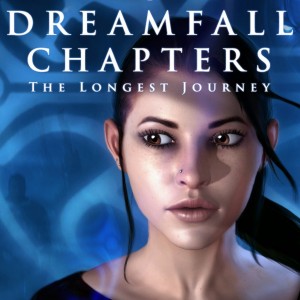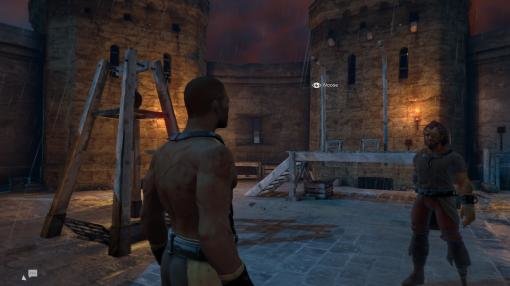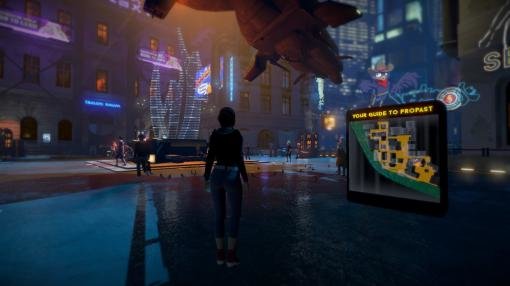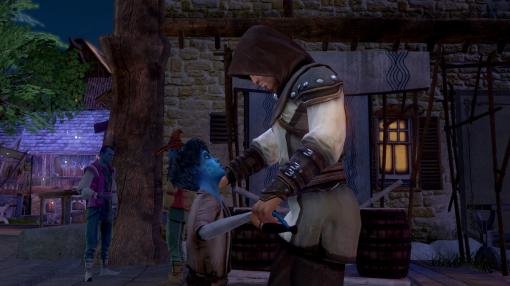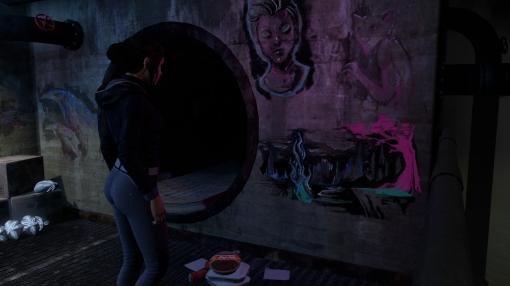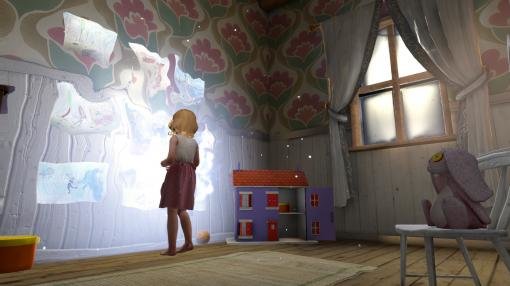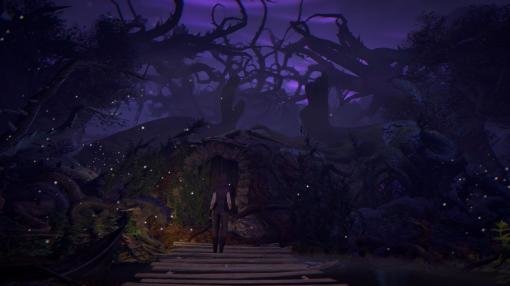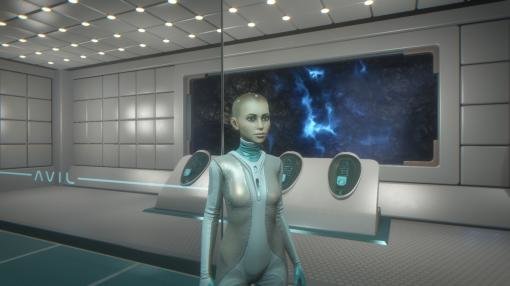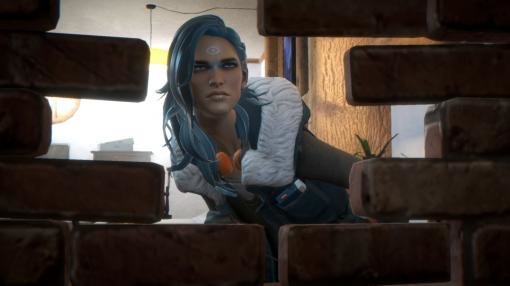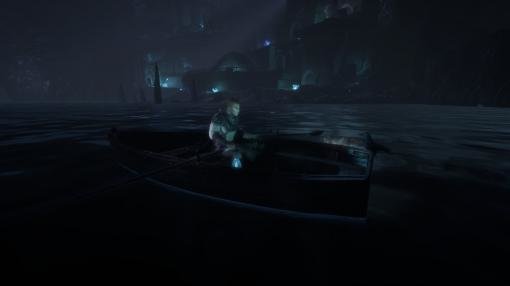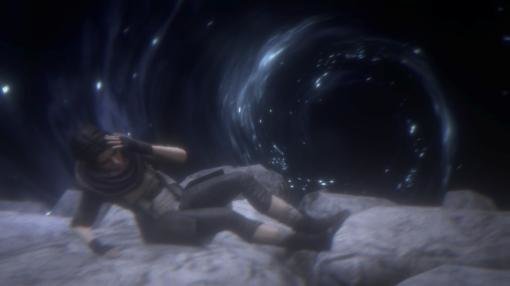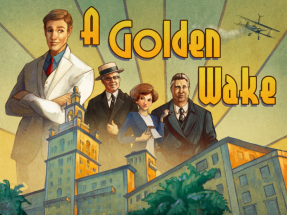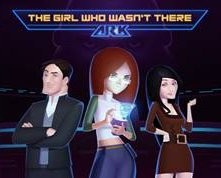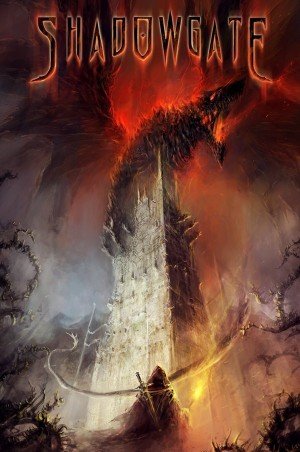Review for Dreamfall Chapters
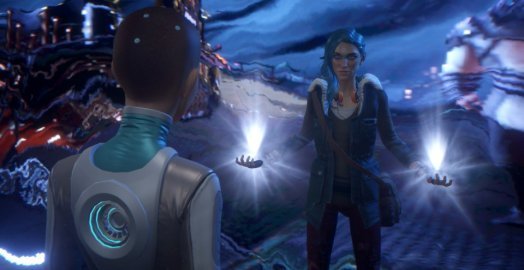
Game information
Adventure Gamers Awards
Note: Various content updates have been applied to Dreamfall Chapters since it began in October 2014, addressing graphical, technical, and gameplay issues. These episodic write-ups are based on their original releases and do not reflect any backdated changes made since time of writing.
Book One – Reborn
As a sequel to a 2006 game that ended with major cliffhangers, Dreamfall Chapters has been a long time coming. For much of the time in between, it seemed we’d never know the fates of Dreamfall’s three protagonists: Zoë Castillo, a listless college dropout whose quest to find her missing ex-boyfriend entangled her in a corporate conspiracy; Kian Alvane, an Azadi assassin questioning his faith on a mission to take down Marcurian rebels; and of course April Ryan, the world-hopping, balance-restoring, art-student-turned-freedom-fighter who first appeared in 1999’s The Longest Journey.
Dreamfall Chapters was announced in 2007 as an episodic game, then shelved without ever going into production. In 2012, series creator Ragnar Tørnquist licensed the IP from his former employer and Kickstarted Chapters for just over $1.5 million. This time it was planned as a single, non-episodic game, but with production taking longer than anticipated, the developers reversed course again, announcing that they would split the game into five “books.” So here we are, finally able to see the end of Zoë, Kian, and April’s stories… or, at least, the beginning of the end.
Spoiler alert for Dreamfall
Book One – Reborn is a gradual opening to what promises to be another beefy Tørnquist tale, but at least those cliffhangers—Zoë hovering between life and death in a coma, Kian arrested for treason, and April felled by a spear to the gut—are addressed early. The episode focuses mostly on Zoë, with Kian briefly playable and April’s situation only teased in the opening cutscene and an intriguing “interlude” near the end. Still, it’s a start, one that should have fans of The Longest Journey particularly excited as loose threads finally start to make sense.
End spoiler
In general, playing The Longest Journey isn’t necessary to enjoy this first episode of Dreamfall Chapters. Dreamfall itself is more important because, as one character even points out, it was only the first half of the story. (If you need to refresh your memory, developer Red Thread Games has posted a recap video.) Book One opens in The Storytime, a snowy dreamscape where Zoë has been trapped for nine months while she lies unconscious in a Casablanca hospital. In the highly technological world of Stark, dream machine use has proliferated, giving rise to an increasing number of junkies addicted to lucid dreams. Zoë’s investigation in Dreamfall established that these machines are Very Bad and Dreamfall Chapters’ opening reiterates this with three puzzle sequences where she uses special mental powers to free people trapped in nightmares. This section also serves as a tutorial for the game’s interface, although the powers themselves (the ability to slow time, read minds, and create light) don’t appear again for the rest of the episode.
Dreamfall Chapters offers keyboard controls as well as support for Xbox 360 and PS4 gamepads. You walk with the WASD keys or left stick and pan the camera with the mouse or right stick. As you get closer to hotspots, an initially inactive circle cursor turns into an eye, hand, or talk bubble, or a gear icon that leads to a submenu if there are multiple possible interactions. This follows a certain real-world logic: you can only interact with something within reach. But during the early Storytime puzzles I didn’t understand that the cursor changed and mistook the inactive circle to mean I couldn’t do anything at all—not exactly the desired reaction in a tutorial meant to ease players into the interface.
This tutorial section also introduces the inventory, which is accessed with the Tab key or by pressing up on the d-pad. With the inventory tray visible at the bottom of the screen, you can examine items you’re carrying, combine them with other items, or try to use them on whatever hotspot is currently highlighted. Certain items, like a flashlight, are visible in the character’s hand during use and must then be pointed in the right direction—an additional layer of inventory use that I didn’t quite get the hang of, but was able to brute force my way through in the rare puzzle that required it.
As the Storytime sequence closes, Zoë must make a decision about returning to her life in Stark. Here’s where you’ll experience the first of several chances to shape the story by choosing between two discrete options, each with the potential to “shift the balance.” (If you’re unfamiliar with the previous games, this refers to the symbiotic relationship between Stark and its twin world, the fantastical Arcadia.) Though it’s obviously influenced by Telltale’s The Walking Dead, even down to the “so-and-so will remember this” messages that occasionally flash on-screen, Dreamfall Chapters positions itself not only as a game about choice but also about consequence (a point its characters keep making, in case you missed it). One such consequence emerges in this very episode, when Zoë’s first balance-shifting decision impacts several of the scenes, characters, and puzzles she’ll encounter later.
With Zoë’s path established, the game shifts to Arcadia, where Kian is imprisoned in Friar’s Keep prison awaiting execution when one of the Mercurian rebels appears to help him escape. Like Zoë’s appearance in Storytime, this serves as a prologue to Kian’s story: we get a recap on the current political situation, solve a few dialogue and inventory puzzles on the way to freedom, and make at least two more crucial decisions that may impact Kian’s story later on.
Before making these story-altering decisions, you have the option to see what other players have done. At the first major decision point, I actually changed my mind when I saw that more than 80% of players so far had chosen the path I was leaning toward, and decided instead to take the road less traveled. But confronted with moral dilemmas while playing as Kian, I couldn’t bring myself to go against the grain even though the percentage skewed even higher. In theory, branching paths add replay value, but I don’t want to muddle my choices and understanding of the story before the rest of the game is even finished. (The save game system doesn’t allow for separate profiles, either. It saves automatically at certain checkpoints and continues from these when you load, with no straightforward way to create a second, alternate playthrough that won’t overwrite your first.) Knowing that these choices will potentially unlock entirely different scenes and puzzles, and that episodic games are sometimes adapted to fit how the audience is playing them, I’m curious how this will shake out over Chapters’ five-episode run. Will the fact that most players leaned a certain way change Red Thread’s plans for content only a handful will see? Time will tell.
The last major section takes place in Europolis, the sprawling technopunk location where you’ll spend the most time in Reborn. Three months have passed since Zoë awoke from her coma. She and Reza are back together, and she’s in therapy trying to deal with her reintegration into society and recover repressed memories—what happened in Storytime is totally lost to her. This sets up a dilemma where the player knows more than Zoë about her own situation, and coupled with the emphasis on choice and consequence, it puts you in the unusual position of deciding whether to focus on Zoë’s future, or try to tip her off to what happened in the past. Chances are the story will be roughly the same regardless of what Zoë reveals to her psychiatrist or says to Reza during a disagreement, but there’s nuance to even these non-balance-shifting choices that makes them more than a gimmick.
Similar to early gameplay in The Longest Journey and Dreamfall, the Europolis section shows us a “day in the life” as Zoë has a therapy session, brings Reza lunch, goes to work (either at a bioengineering lab or a droid shop), and volunteers at the campaign office of a politician running in the upcoming election. Even though it’s set 200 years in the future, this series has always stood out for its true-to-life female protagonists, and Chapters continues the tradition by letting us get to know Zoë (again) through seemingly mundane activities and the lively entries in her journal. The gameplay here is leisurely paced and feels like an intro to a larger adventure, but in a self-contained episode it does have a listless quality. I appreciated how the gameplay fits in with tradition, but I reached the end of Book One regretting that not much had happened.
The meandering pace is compounded by the difficulty of navigating the sprawling Europolis, whose streets and alleys can be freely explored right away. Overcast, overrun with neon lights and lens flare, and bustling with activity, Europolis’s Propast district is a place teeming with NPCs (many named after Kickstarter backers), where aircraft fly overhead and ad-bots zoom past at eye-level, graffiti artists leave their marks on building walls, merchants hawk their wares, and junkies lie on benches and sidewalks with their faces hooked up to dream machines. The city exists on three levels with distinct areas, including a Chinese market, riverside docks, and the ironically named Sonnenschein Plaza, the only place in Propast with (albeit artificial) sunlight.
Unfortunately, all this activity comes with a price, as Europolis is a serious resource hog. I went from having no performance issues in Storytime and Friar’s Keep to the game slowing to a dead crawl the first time Zoë emerged onto the city street (followed by a blue screen crash). Turning the graphics quality and anti-aliasing down improved things—and I didn’t even notice much difference; the game is beautiful even on low settings—but I still had occasional frame rate issues in Europolis consistent with problems many other players have reported. [Note: Red Thread has released a patch that addresses some of these issues.]
Performance issues aside, Europolis is a maze-like place that you need to find your way around as Zoë goes through her day, and even if you don’t keep getting lost (which I did!), traversing the area on multiple errands takes time. The developers have stated their desire to create a big open world to be explored, and they’ve certainly done so here: Zoë can eavesdrop on conversations, make observations about people, landmarks, and posters on the walls, and even have side interactions with a few NPCs. All of this supplements your understanding of the game world, and the script is consistently well written, but I didn’t get enough out of my wandering to justify the amount of it I had to do to find each necessary location. “You are here” shopping mall-type maps are distributed around town but no corresponding mini-map displays on screen, so as soon as you walk away it’s easy to get turned around again. I hope the developers add an option to quick travel from a map to the desired location in future episodes.
This series is known for lots of talking, and dialogue is certainly present here, but much of it is optional and up to the player’s curiosity. For example, at the end of her therapy session, Zoë can leave right away or linger and make small talk with her psychiatrist, an option that unexpectedly veers off to shed light on Zoë’s insecurities about her relationship with Reza. Skipping the chat likely wouldn’t have changed the overall story, but this insight did influence my decisions around Reza later on, including during a balance-shifting moment.
Though both the writing and voice acting are high quality, conversations would be more rewarding if they included dynamic character animations and more camera cuts. It seems like a waste of 3D to have characters just standing there as they chat back and forth. Plus the lip-syncing is weird: characters’ mouths barely move for multiple words then suddenly open, in a puppety sort of way. (This might be related to performance issues, but it was a consistent annoyance for me throughout Reborn.) Still, the well-written dialogue is engaging, often funny, and generally worth seeking out. By the end of the episode, Kian remains an enigma, but I felt I got to know Zoë well through her conversations with others, and considering we’re going to be spending a lot of time together, that’s crucial.
This getting-to-know-you period is helped along with insights into what the player character will say before they say it. In so many games, you pick an option thinking you know what you’re doing and find, too late, that you misinterpreted the writer’s intent. In Dreamfall Chapters, you get to know the protagonists not only through what they say, but also by exploring what they intend to say, which is presented verbally when you mouse over each dialogue choice. So to an extent, you can sync the character’s dialogue and actions to your own feelings about what’s happening. This mechanic doesn’t prevent the occasional mix-up; in fact, one late interaction with Reza went so differently than I expected that I replayed it to keep the unintended consequence off my permanent record. But overall, Dreamfall Chapters gives players a refreshing amount of control over how the protagonists present themselves to the people they encounter, and this made Book One enjoyable beyond the more obvious puzzles and story beats.
Speaking of puzzles, this episode has some, but not many considering its 5-6 hour runtime. (My playthrough included a fair amount of optional dialogue but even more time lost in Europolis.) Though the mind tricks we learn in The Storytime don’t reappear, the Friar’s Keep and Europolis sections are peppered with more traditional adventure puzzles where you use dialogue, inventory items, and deductive logic to get past blocking obstacles. (Thankfully, the finicky combat and stealth sequences that blighted Dreamfall are nowhere to be found.) In either of her job paths, Zoë interacts with a droid she can direct to enact certain puzzle solutions. I found these sequences inconsistent—one where she and the droid work together to clear debris from a river got my puzzle-brain firing, while another where Zoë literally tells the droid to move left, right, up, and down around a simple grid felt like pointless busywork. Especially considering how much of my experience was spent finding my way around Europolis, I have to admit that a lot of what Book One had me doing didn’t wow me, but I was engaged enough by the writing and getting to know the characters and the world to be sucked in anyway. And that interlude at the end—I don’t want to spoil anything, but it has me seriously intrigued.
Considering its Kickstarted origins, Dreamfall Chapters is an impressive production that consistently looks amazing. From the detailed character models to the surreal, snow-blanketed Storytime to the dazzling lights and grit of Europolis, this is another stylish Dreamfall game. The music and voice acting are quality, too. Zoë and Kian are both voiced by new actors, but I hardly noticed. Unfortunately, the bugs distract from otherwise excellent production values, as do graphical clipping issues in the final interlude. Breaking the game into episodes was meant to get content to waiting backers sooner, but these issues make the release seem rushed. As eager as I am to keep playing, I hope Red Thread can find a good balance between delivering content regularly and taking the time they need to bug fix and polish.
For fans of this series, the wait for closure is far from over since Dreamfall Chapters still has four more episodes to go, with no official release schedule announced. Even so, Book One – Reborn is a promising, meaty intro that made me feel like I did playing Dreamfall and The Longest Journey for the first time. I’m eager to see where my choices lead, especially thanks to the teaser text that displays before the credits that hints at what the consequences of each major choice will be. But with no idea how long we’ll be waiting for Book Two, can this enjoyment and anticipation withstand an episodic delivery? Here’s hoping.
Book Two – Rebels
I just finished Book Two of Dreamfall Chapters, and boy are my feet tired.
I’m sad to say I didn’t enjoy this episode, and that’s mainly because of all the aimless wandering. In Book Two – Rebels, Kian and Zoë each have two playable sections, all four of which are dominated by traversing large city areas (Marcuria for Kian; Propast for Zoë). In both worlds there are maps posted around town, but as I griped about earlier for Book One, there’s still no mini-map to help you keep track of the area you’re travelling, and no option to jump to a point on the map. Twice, even the posted maps become useless when you’re tasked with finding a specific location that isn’t labeled. Why, Red Thread, why?!
But let’s back up a bit. Book Two opens in the fantasy world of Arcadia with Azadi traitor Kian Alvane in the hands of the Resistance—a group of magical rebels standing up to the soldiers who are pushing them out of the city of Marcuria—and much of his gameplay is spent running errands to prove that the rebels can trust him. The navigation this requires makes Kian’s sequences tedious, but even worse from a story standpoint, I don’t particularly care about Kian. He’s always been the strong silent type; in the original Dreamfall that didn’t matter much because 1) his screen time was minimal, and 2) his storyline had built-in tension due to its ramifications for April, who I did care about. But Kian is a headliner in Dreamfall Chapters, and his bland stoicism isn’t cutting it. He’s working with the rebels because he’s been given no other choice—ironic, in a game so focused on choice and consequence—but does he believe in their cause? I can’t tell. His motivations are a mystery, and nothing noticeably changes for him as he carries out a number of random tasks that don’t do much to advance the story.
Then there’s this huge plot inconsistency related to a magic veil Kian is wearing to mask his identity. Supposedly it keeps him concealed from anyone he doesn’t want to see him, but in reality this only holds true when it’s convenient for the story and not, for example, when a kid crashes into him in the town square in a pickpocketing attempt, or when a guard spots him from yards away during a stealth sequence. He’s clearly an Azadi, so the writers obviously felt the need to explain why other Azadi don’t recognize him on the street, but the over-complicated contrivance confuses Kian’s situation more than it helps.
When I managed to find my way around Marcuria’s complex map, Kian’s tasks were relatively easy to carry out, if not much fun. A finicky stealth sequence frustrated me, a long one-sided conversation with a Resistance ally bored me, and the one sequence I actually liked—recalling details Kian observed during a political rally to identify a turncoat—I messed up the first time due to unintuitive UI. (The choice reportedly has consequences, so I immediately reloaded from the last checkpoint, which required running around town another ten minutes to get back to where I’d been…) Let’s just say I was relieved to finally get out of Arcadia and meet up with Zoë again in Stark.
Zoë’s sections are more interesting, with some repercussions of earlier choices playing out and with tension ramping up as EYE agents occupy the city of Propast. But Zoë’s gameplay is also rife with Wandering Around Syndrome, and because the EYE has blocked off streets that were previously accessible, getting around is even more of a challenge than in Book One. At least her tasks propel her storyline, with her struggle to remember what happened pre-coma, her relationship issues with Reza, and the political campaign she’s working on all developing to some degree. She also has a dream sequence wearing her white undies—it wouldn’t be Dreamfall without those white undies!—that suggests a welcome link between her storyline and what’s happening in Arcadia.
Book Two introduces a few new characters, the standout being Enu, a rebel magical with a habit of putting her foot in her mouth. Except for a graphical nod on the menu screen, the surprising interlude that closed Book One isn’t addressed at all, nor are Zoë’s special powers, which were so heavily emphasized in that episode’s opening. Technically, the graphics, voice acting, and music are on par with the prior episode. Book Two frequently suffers from inconsistent audio levels, however, so when people near Kian or Zoë are talking it’s almost impossible to hear their own voice lines. This is particularly troubling during “walk and talk” scenes, like when Kian must follow someone through town who’s blabbing the whole way, and at the political rally where Kian’s mumbled observations, needed for a puzzle solution, are drowned out by the man on stage giving a speech. Adjusting sound levels in the options doesn’t improve this; the only fix seems to be turning on subtitles, which detract from the cinematic visuals.
When I finally reached the end of Book Two after almost nine hours, I’d spent so much time wandering that I could barely remember what had happened story-wise. That’s not ideal in a game with story at is core, especially one that’s being released with several months between episodes. (Disclaimer: my playtime, and my annoyance, was impacted by multiple blue screen crashes in the first few hours. Switching from the Steam version to the GOG version ultimately solved the problem.)
With two episodes down and three to go, I’m somewhat intrigued by what’s going on in Stark and eager for Zoë to fill in the blanks about her coma, but I’m just not that interested in the goings-on in Arcadia. In fact, without April as their leader, I don’t care about the Resistance at all. I know I should, what with magicals being rounded up and shipped off to concentration camps. Kian even has a conversation with a little boy about whether it’s fair for the Azadi to hate him because his skin is blue—not exactly subtle. It’s obviously set up as a situation worthy of empathy, but for now there’s still a personal connection missing, a reason to care that the original Dreamfall provided through April Ryan. That’s why I hope Zoë makes it to Marcuria soon; if not, the rest of Dreamfall Chapters has the potential to be a very long journey.
Book Three – Realms
Dreamfall Chapters’ second episode left a pretty bad impression on me, so I’m happy to report that Book Three – Realms is better. Not enough to wipe out all the complaints, but at least I didn’t come through it kicking and screaming this time.
This episode is shorter, clocking in at around five hours, and that’s totally fine. I play episodic games expecting small chunks of story over time, and this length felt more manageable than the previous episode. The peculiar little girl Saga is back in another “interlude,” followed by a couple of segments each for Zoë and Kian. And, in a nod to the passage of time since Book Two, all three characters look noticeably different than their previous incarnations, giving the much-needed sense that the story’s forging ahead.
I kept quiet about Saga the first time around, for fear of inadvertent spoilers, and I’ll refrain again other than to say that this interlude hints strongly at how April Ryan plays into Dreamfall Chapters’ story. The sequence itself is a massive scavenger hunt that I enjoyed for the first 15 minutes or so but tired of as it stretched out to an hour. Between finicky hotspot labels that only show up when the camera is angled just right and a dearth of clues, it’s a digression right off the bat that drags on way longer than it needs to, and like Book One’s interlude, this sequence also ends with a cliffhanger that isn’t addressed in the subsequent chapters. I’m realizing why this bugs me: Saga’s role in the story is more intriguing to me than Kian’s or even Zoë’s, and I want to stick with it. Hopefully these interludes will have a satisfying payoff eventually, but for now I’m frustrated that the aspect of the story I’m most curious about is being doled out in such tiny morsels.
Kian’s up next, back in Marcuria at night. Some of his previous choices are alluded to in the context of the ongoing Azadi/rebel struggle, but I didn’t get a strong sense that they significantly changed the outcome. Players who replay to see how outcomes differ may appreciate the choice-and-consequence elements better, but due to episode length and the absence of separate saved game profiles, Dreamfall Chapters isn’t well suited to replaying between episodes. In this book there are hardly any decisions to be made, including during several long dialogues that seem perfect opportunities for choices about what to say but instead play out as non-interactive cutscenes. (One of these goes on longer than 15 minutes, rivaling The Longest Journey’s infamous history lesson.) I can’t help wondering if Book Three’s meager choices mean the designers are less excited about the concept than they were early on, but hopefully this is just a case of mid-game doldrums, with this central episode pivoting from the build-up in Books One and Two to the story’s climax in Four and Five.
Regarding Kian’s gameplay, he may have a new hairdo but he’s still running around town with no clue what he’s looking for. Like in the previous episode, most of Kian’s tasks involve finding items in one area to use in another area. His goals are often vague (for example: “incapacitate the mechanic,” without insight into how he might do that) and the items he can use aren’t labeled until he needs them, so you can’t start working out puzzle solutions ahead of time and must re-explore the whole map whenever his objective updates. Thankfully the running is confined to a small area this time, with most of the city walled off, and the areas he can access look different thanks to the Azadi’s increased presence and an upcoming harvest festival. But even though Kian has some new scenery to check out and a few conversations to engage in, I was disappointed by the lack of clues provided in either dialogue or the environment. I went online for hints repeatedly during Kian’s first section—hints I would have much preferred hearing in his own voice. On the bright side, the smaller map significantly cuts down on the wandering.
Zoë finally gets to do more than errand running in this episode, and that’s a very welcome change. Her path around Propast has also been streamlined, in a blatant way that seems to condescend to people like me who complained about the navigation, but beggars can’t be choosers. Zoë’s chapters deepen her search for answers about her coma and finally land her in Marcuria, where she meets up with Crow—not my favorite TLJ character, but I was relieved to see him! Even if she and Kian don’t interact in this episode, with Zoë in Arcadia (in broad daylight, no less) the story finally seems poised to pick up momentum.
Speaking of story, up until now there have been two plots unfolding, both complicated and hard to follow. In Stark there’s a political election, corruption, EYE officers imposing martial law, and WATICorp (makers of the Dreamer and Zoë’s beloved Watilla) somehow mixed up in it all. In Arcadia there’s the ongoing resistance, some political high-ups with funny names trying to wrest power from some other high-ups with funny names, and a little blue-skinned boy named Bip who Kian has taken a liking to.
I wish I could say more about the developing narrative, but even three episodes in this is basically all I know. There are so many bit players and names without context, so much backstory being delivered in dragging dialogues, so many revelations that seem important to the characters but bounce right off me. Maybe this complex a story doesn’t fit well in the episodic format, when there are months between episodes to forget who’s who. Maybe my mind wandered during one too many cutscenes and I forever lost the thread. I truly wish I cared more about Dreamfall Chapters’ story; I’d probably be more forgiving of the gameplay if I did. On the other hand, this is a game (partially) funded by TLJ’s and Dreamfall’s most hardcore fans, and satisfying them might call for a plot that’s hard for the rest of us to appreciate. I can only speak to my own experience.
All of this being said, one particular sequence stood out to me in this episode as being… well, fun. It takes place in a warehouse where Zoë must reprogram a bot to help her evade some bad guys, and for a few minutes I lost myself in the challenge of figuring it out. I wish Dreamfall Chapters had more gameplay like this, with a clear goal, puzzle pieces in relatively easy reach, and enough clues to work out a solution using my very own brain. It’s strange to pause after sinking 18-plus hours into a game to think, “Hold on a minute, I’m actually having fun here!” The fact that I did so in Book Three makes me a little more optimistic about the rest of the journey than I was before.
Book Four – Revelations
Confession time: I’m bored with Dreamfall Chapters. So bored that after playing Book Four – Revelations when it released in December, I put off writing up my experience for so long that I had to replay the episode to remember what happened. (Ha, I showed me! Oh, wait.)
By the fourth episode, I shouldn’t be struggling to explain what this game is about. And yet, 20-plus hours in (3½ of those spent on Revelations, not counting the second playthrough), I still don’t really know. Some things, I get: the rebels are up against a malevolent military force; Zoë wants to help them and the rest of Arcadia (and Stark too, I guess?) by finding “the dreamer,” who’s in some sort of trouble in an unknown location; Kian is breaking into an Azadi prison camp to try to save Bip, the little blue boy who stole his wallet a few episodes back. But then I come to the question of “why?” and things start to fall apart. What’s motivating Zoë and Kian to do what they do? What’s the actual story driving Dreamfall Chapters forward? I’m not talking about the voluminous backstory bystanders are constantly spewing, but the here-and-now story, the growing conflict that’s raising the stakes and spurring Zoë and Kian to act. That’s the part I can’t articulate, and that bothers me. Sure, sometimes stories get muddled in the middle, but by this point Dreamfall Chapters should be homing in on the end-goal, pushing toward the finish line. It doesn’t feel that way to me.
With the exception of a closing “between worlds” interlude, Book Four takes place entirely in Arcadia, with Zoë getting most of the action (so to speak). She interacts with some rebels in a long sequence that’s all talk talk talk, very easily gets into a place that would have had a more satisfying payoff if she’d had to strategize a bit, randomly bumps into Brian Westhouse (remember that guy? Don’t worry, it doesn’t much matter), conveniently finds out how to get to the faraway place where Abnaxus and the dreamer are, hears the crazy story—twice!—about how April Ryan trapped Roper Klacks in a calculator back in The Longest Journey, and finally gets the hell out of Marcuria.
The havoc she and Crow apparently wreaked off-screen to secure passage to the Purple Mountains is alluded to in a cute dialogue, but that only calls attention to the fact that the first portion of the episode has little importance overall—it’s a drawn-out explanation of how we got from points A to B that could have been more engaging with different emphasis and higher stakes. What if Zoë had to find / steal the key to Abnaxus’s abode rather than having it handed to her? What if the person preventing her from entering the abode knew who she was and was targeting / outsmarting her, rather than a random jerk artificially blocking her way who’s easily distracted with a clunky “tell Crow where to fly” puzzle?
Once Zoë gets out of Marcuria, she and Crow bump into some chatty mole-people, Zoë solves a couple of puzzles with her mind (good thing they’re easy to brute force, since I don’t remember what any of those powers do), and she wins the equivalent of a boss fight almost by accident. It’s all easy stuff, padded with lots of drawn-out, seemingly incidental conversation. But at least she’s finally on the move, and after so much time spent in Marcuria, Book Four offers a welcome change of scenery. The most interesting of these new locations harkens back to the barren dreamland where this journey began, offering up a surreal take on the Baba Yaga myth, but burdened with dragging dialogues and lacking a clear sense of what Zoë stands to lose or gain, the sequence seems to carry much more weight for the characters in-game than I took away from it.
As for Kian, he spends an early scene contemplating whether every choice he’s made so far makes him a good person or bad person, and then you might see an optional dramatic moment depending on the decisions you’ve made. (I can’t go into more detail without spoilers and don’t know what to say about it anyway, other than that Kian’s attempts at self-discovery have felt forced all along. I don’t believe him as a character.) In a questionable interface tic, the game flashes a message on the screen to make sure you know this is an optional scene, which totally broke my tenuous concentration. The prison camp turns out to be a not-at-all-veiled allusion to Auschwitz, and after two more rounds of sneaking past oblivious Azadi soldiers, the big baddie Kian encounters is so jarringly out of place in this world—seemingly parodying a well-known character from a 1990s horror movie—that for a second I wondered if I’d slipped into some alternate dimension fan game.
Obviously, if you’ve enjoyed Dreamfall Chapters thus far and have disagreed with my opinions on the previous Books, your experience with the latest installment probably doesn’t resemble mine at all. All through my second playthrough, I tried to zero in on why I’m not enjoying this game when I had a decent time with The Longest Journey and Dreamfall, and I think it has a lot to do with its heavy reliance on the previous games. I liked those games well enough at the time, but I can’t quote them back to you. Bopping around pretty landscapes just to hear from NPCs about all this stuff that already happened isn’t enough to keep me interested. Dreamfall Chapters started out as a Kickstarter, so some fan service is to be expected, but a sequel should be more than a rehash. With the exception of the Saga interludes, nothing about this game’s story is engaging me at this point.
In fact, it’s pretty telling that the story thread that continues to interest me the most—those interludes—have the least obvious reliance on lore and backstory established in the first two games. Speaking of Saga: her brief section this time is similar to the last two, but with smoother controls and a bit of brainwork built in. I enjoyed the interlude, both from a “wow, I’m solving puzzles here!” standpoint and for observing how her character has changed since we last saw her. Even if the gameplay hasn’t always been graceful, Saga and her weird house are my favorite aspect of Dreamfall Chapters.
Book Four – Revelations ends with Zoë, and it’s a powerful closing moment—well, sort of. It has a “whoa, what just happened?!” quality, but with the dangerous potential to be setting up a “just kidding!” cop-out, so we’ll see. By the second-to-last episode I want to feel like the story’s barreling forward, there’s no stopping it, the writers are going to deliver an explosive conclusion or die trying. With Dreamfall Chapters, though, I have no idea what to expect from Book Five. Without even really knowing what needs to be resolved, story-wise, it’s hard to look forward to that resolution.
Book Five – Redux
Nearly two years after Dreamfall Chapters’ first episode, the journey has ended. Book Five – Redux ties up many loose ends left flapping in the breeze by the original Dreamfall’s cliffhanger ending—in fact, it feels more like a conclusion to Dreamfall than to Dreamfall Chapters, as if the four episodes leading up to this didn’t matter much. Those who mainly played Dreamfall Chapters looking for answers might be okay with that. But if you’re going into Book Five hoping for a cohesive end to this story, prepare for disappointment.
You play as all three characters in Book Five—Zoë, Kian, and Saga—in some familiar locations (Saga’s house, Zoë’s Casablanca hospital room, Storytime) and some new ones (the giant Azadi machine, a futuristic lab). This episode, which took me about 5½ hours to complete, is more heavily weighted toward cutscenes than gameplay. A lot of Big Things happen in cinematics—people rally to fight, go to war, betray each other, die. The impact these cutscenes have on you will depend on how closely you’ve been following the Azadi subplot and how well you remember the multitudes of supporting characters. For me, some of the revelations involving characters I cared about were stirring or poignant. One even made me cry. But many involved characters I didn’t care much about, which gave the episode’s pacing an uneven quality as boxes were checked off and all the various subplots wrapped up tight.
Gameplay-wise, the episode didn’t start off well for Zoë and me. The initial scene, which should have taken about ten minutes, dragged out to an hour as I circled a single small room unsure what to do. (Tip for this scene: click on everything repeatedly. Even if you think you already did. Do it again.) Sadly, segments like these have dragged down Dreamfall Chapters all along. Some environmental clues or ”Maybe I should look at…”-type suggestions from Zoë would have gone a long way.
Zoë soon starts making unexpected discoveries about where she is, what’s been going on, and what it all means. Some of the revelations make sense. A lot of them don’t. I remember Dreamfall getting similarly “out there” near the end, and I suspect some die-hard fans will love where Dreamfall Chapters ends up, but I had a hard time keeping up with the leaps in logic and pseudo-science. Of course, it’s been ten years since I played the original Dreamfall. The long episodic run of Dreamfall Chapters hasn’t helped; even people who played or replayed Dreamfall right before jumping into Chapters are probably fuzzy on the first game’s intricate ending by now.
Like the first scene that took me way too long, a hotspot hunt at Saga’s (yep, another one!) stretched out as I combed her house for items needed to fulfill a prophecy she’d learned about off screen. Wandering through Saga’s house is nothing new in this game, but this time it’s more troubling because she’s finally become part of the larger story, but without any satisfying explanation as to how or why.
In this final interlude, an adult Saga is picking up ingredients needed for an elixir she inexplicably needs to make. Apparently she’s an alchemist now, even though it’s never come up before. She’s also a musician who can travel between worlds on “songlines.” (Odd; when we’ve seen her go through portals before, they had had nothing to do with music.) We don’t find out how the elixir fits in until later, so there’s absolutely no sense of time pressure or urgency while scrounging up the ingredients. And when she does eventually meet up with Kian and Zoë, her arrival is so abrupt and random (complete with refrains of “Wait, who are you?” from various other characters), it seems like the writers have used her to conveniently fill in the blanks. “Not sure how to wrap this up… I know, let’s stick Saga in there!” I know, I know, it’s not that simple. But that’s what it felt like to me—like Saga’s an extra who’s been pacing around off-stage waiting for her one big scene, a plot device who never earned her place in the story. And that sucks, because Saga’s the one character I’ve been most intrigued by all along.
In the scene she shares with Kian and Zoë, Saga says more than once that she’s only following orders, facilitating a story that’s already been written. “Sorry guys, I’m just as confused as you are, but the developers told me to do this.” These blatant nods to the storytellers further call attention to how poorly Saga’s subplot has been integrated into the overall narrative. If only the three interludes leading up to this had foreshadowed Saga’s final task in some way, giving the sense from the beginning that the story had already been written…
Book Five has two maze-like locations that I found difficult to navigate, mainly because they’re so dark. (One of these is played as Saga, the other as Kian.) Turning up the gamma in the game settings only succeeded in washing out the visuals, and in Kian’s location, high up in the Azadi machine, visual effects got distorted and made it even harder to see where I was going. In both cases I had to consult a YouTube playthrough, and when even that didn’t help with Kian’s predicament, I eventually had to resort to sweeping my cursor around looking for hotspots while I slowly wandered the catwalks—another form of pixel hunt, really. Boo.
Kian does get a few minutes of puzzle solving to help Crow out of a sticky situation, and Zoë plays some of her brain games when she’s unable to use her hands. These tidbits provide welcome interactivity, but they’re over too soon. The only other real gameplay in Book Five involves Zoë running away from bad guys in pursuit. These stealth-like sequences often result in death followed by an immediate do-over, which gets really frustrating when you don’t have enough time to come up with a new solution before you’re caught again. But this is nothing new in Dreamfall Chapters; Kian has been dodging Azadi guards this way all along.
In the early books, much ado was made about choice and consequence. This emphasis dwindled later on, and in Book Five it’s all but gone. At the beginning of the episode, text descriptions remind you of your major choices so far and reveal their results, but those explanations feel insignificant in the absence of a strong connection to the story. I’ve had a hard enough time keeping all the subplots and supporting characters straight. Being told how a choice I made months ago affected characters I don’t know that well, during events I barely remember, didn’t have a strong impact on me. In the end, all those choices just didn’t seem to matter.
Of course, “player choice” is trendy lately thanks to the success of games like The Walking Dead, but it doesn’t work in every game. If the story’s already been written—as Saga insists too many times to be a coincidence—why give players choices at all? Why was so much choice and (alleged) consequence integral to this story? Ultimately I don’t think it was. The early episodes’ emphasis on player agency only muddied an already complex storyline and set the wrong expectations.
In spite of these gripes, I enjoyed Book Five more than some other episodes. I liked the feeling that the story was finally going somewhere, the tying up of loose ends (even if many explanations were hard to swallow), and the sense of finality as characters acknowledged that the journey was ending. I’m fond of meaty, emotional endings, and Dreamfall Chapters didn’t disappoint me there—it does a good job of conveying the “epicness” of its conclusion, even if a lot of that epic is smoke and mirrors.
The last scene was my favorite in the episode—one of my favorites in the whole game, actually—but not because it’s action packed or riddled with hard moral decisions or chock full of puzzles. This closing scene is quiet. Time has passed. Characters we’ve traveled with have aged. For a few minutes, exploring a well-worn location took on new meaning as I learned, through hints and glimpses, about other adventures that have taken place in these worlds. In the game’s closing moment, I had the satisfied sense that this is how the story was supposed to finish. It was the right ending. I was glad I got the chance to see it.
This is the sort of storytelling and emotion I know Ragnar Tørnquist and team are capable of. That’s why so much of the chaff in Dreamfall Chapters has annoyed me so much. I don’t know what Dreamfall Chapters was originally intended to be, if the episodic release changed it or only stretched it out, if the budget was enough to make the game the developers wanted, if the result matches their original vision. Making games is hard, especially one based on a license with such pent-up expectation, and even more so under the watchful eyes of 24,120 Kickstarter backers. Red Thread has delivered what they promised: a true sequel to Dreamfall, a conclusion to a story that didn’t have proper closure. And they’ve done a lot of things well. The graphics are stunning. Vast worlds have come to life, from Stark to Arcadia to the Storytime in between. Patches have been issued throughout the episodic run to improve technical performance and address player feedback about certain gameplay issues. I’m sure it’s been an exhausting process, and I genuinely feel bad that I didn’t like this game more. I wanted to love Dreamfall Chapters, I truly did.
If you’ve been playing the episodes as they release, we’ve reached the end of our journey together—either you agree with me or you don’t. (For your sake, I hope you don’t!) But if you’re someone who was waiting to play Dreamfall Chapters until all five books were out, my advice is this: play Dreamfall first. Maybe even start with The Longest Journey. Make an event out of it; play them all in a row. The story is just too hard to follow without that foundation, and if you’re not enjoying the story, what remains of Dreamfall Chapters isn’t enough to carry a 25-hour game.
Replacement review copy provided courtesy of GOG.com.




